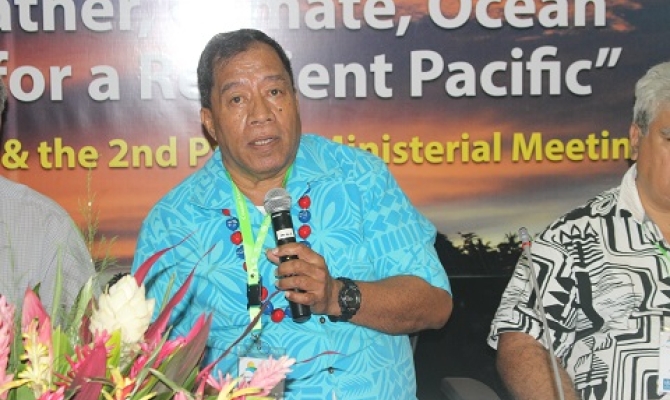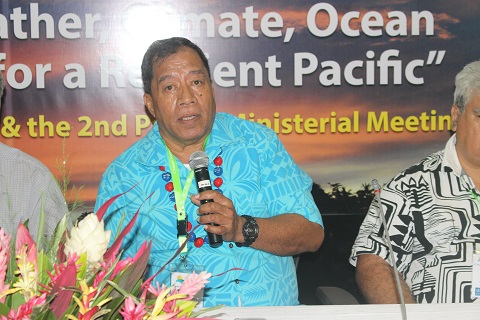
Climate Change Resilience
By Ruci Vakamino of Wansolwara
16 August, 2017, Honiara, Solomon Islands, PMC-4 – The Pacific Island Marine and Ocean Services (PIMOS) panel has made progress on its key priorities of coastal flooding and safety of life at sea.
According to the outgoing PIMOS chair, Dr Tommy Moore, their biggest project at the moment is the Coastal Inundation Forecasting Demonstration project that is currently underway in Fiji.
“This is the second phase of that program and it started early this year and I think this current phase is focusing on Maui Bay and Nadi town,” he said.
Dr Moore said the panel felt coastal flooding and safety of life at sea were the greatest priorities for the region.
“We needed something to focus our efforts on because there’s a lot of work that can be done. We needed something to really keep us on point.”
He added that last week Samoa asked the panel to look at climate change and ocean acidification.
Samoa Meteorological Division Assistant Chief Executive Officer Mulipola Ausetalia Titimaea said that for Samoa, this means they can better monitor the situation and health of their oceans.

“Ocean acidification is an impact of climate change. This is because of the carbon dioxide,” Titimaea explained.
He added that excess carbon dioxide in the atmosphere is absorbed by the ocean and causes the an increase in the ocean’s acidity.
“That’s why it is quite important to monitor ocean acidification,” Titimaea reiterated.
Niue and Fiji were elected as co-chairs of the panel in a meeting on Saturday, August 12.
One of the roles and responsibilities of the PIMOS panel is to look for options to improve coastal inundation forecasting and disseminating information to vulnerable communities. – #PMC4 #PacificMet
The Fourth Pacific Meteorological Council is being held in Honiara, Solomon Islands from the 14 – 17 August co-hosted by the government of Solomon Islands, the Secretariat of the Pacific Regional Environment Programme (SPREP) and World Meteorological Organization (WMO). This will followed by the Second Pacific Meteorological Ministers Meeting (PMMM) on the 18 of August.
The PMC and PMMM is supported by the Government of Solomon Islands, SPREP, WMO, Government of Australia through the Climate and Oceans Support Programme (COSPPac) and Pacific Australia Climate Change Science and Adaptation Planning Programme (PACCSAP), Government of Finland, National Ocean and Atmospheric Administration (NOAA), United Nations Development Programme through the Resilience in the Pacific (SIDS) project.
The PMC consists of members of the Pacific National Meteorological and Hydrological Services supported by its technical partners, regional organisations, non-government organisations and private sectors.
This article was developed by a Pacific Media Team of Reporters currently providing coverage on the Fourth Pacific Meteorological Council in Solomon Islands. This activity coordinated by SPREP is supported by a partnership between the Government of Solomon Islands, SPREP, Australia funded project (Climate and Oceans Support Program (COSPPac) and UNDP Disaster for Pacific SIDS (RESPAC) project.
The views and opinions expressed in this article are those of the writer and do not necessarily reflect the views of the Secretariat of the Pacific Regional Environment Programme (SPREP) or the United Nations Development Programme (UNDP)both of which provided funding for generating media articles.
16 August, 2017, Honiara, Solomon Islands, PMC-4 – The Pacific Island Marine and Ocean Services (PIMOS) panel has made progress on its key priorities of coastal flooding and safety of life at sea.
According to the outgoing PIMOS chair, Dr Tommy Moore, their biggest project at the moment is the Coastal Inundation Forecasting Demonstration project that is currently underway in Fiji.
“This is the second phase of that program and it started early this year and I think this current phase is focusing on Maui Bay and Nadi town,” he said.
Dr Moore said the panel felt coastal flooding and safety of life at sea were the greatest priorities for the region.
“We needed something to focus our efforts on because there’s a lot of work that can be done. We needed something to really keep us on point.”
He added that last week Samoa asked the panel to look at climate change and ocean acidification.
Samoa Meteorological Division Assistant Chief Executive Officer Mulipola Ausetalia Titimaea said that for Samoa, this means they can better monitor the situation and health of their oceans.

Director of Samoa Meteorological Service, Mulipola Ausetalia Titimaea
“Ocean acidification is an impact of climate change. This is because of the carbon dioxide,” Titimaea explained.
He added that excess carbon dioxide in the atmosphere is absorbed by the ocean and causes the an increase in the ocean’s acidity.
“That’s why it is quite important to monitor ocean acidification,” Titimaea reiterated.
Niue and Fiji were elected as co-chairs of the panel in a meeting on Saturday, August 12.
One of the roles and responsibilities of the PIMOS panel is to look for options to improve coastal inundation forecasting and disseminating information to vulnerable communities. – #PMC4 #PacificMet
The Fourth Pacific Meteorological Council is being held in Honiara, Solomon Islands from the 14 – 17 August co-hosted by the government of Solomon Islands, the Secretariat of the Pacific Regional Environment Programme (SPREP) and World Meteorological Organization (WMO). This will followed by the Second Pacific Meteorological Ministers Meeting (PMMM) on the 18 of August.
The PMC and PMMM is supported by the Government of Solomon Islands, SPREP, WMO, Government of Australia through the Climate and Oceans Support Programme (COSPPac) and Pacific Australia Climate Change Science and Adaptation Planning Programme (PACCSAP), Government of Finland, National Ocean and Atmospheric Administration (NOAA), United Nations Development Programme through the Resilience in the Pacific (SIDS) project.
The PMC consists of members of the Pacific National Meteorological and Hydrological Services supported by its technical partners, regional organisations, non-government organisations and private sectors.
This article was developed by a Pacific Media Team of Reporters currently providing coverage on the Fourth Pacific Meteorological Council in Solomon Islands. This activity coordinated by SPREP is supported by a partnership between the Government of Solomon Islands, SPREP, Australia funded project (Climate and Oceans Support Program (COSPPac) and UNDP Disaster for Pacific SIDS (RESPAC) project.
The views and opinions expressed in this article are those of the writer and do not necessarily reflect the views of the Secretariat of the Pacific Regional Environment Programme (SPREP) or the United Nations Development Programme (UNDP)both of which provided funding for generating media articles.